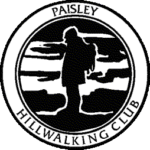New To The Hills? Information for New Starts
New to hillwalking, or maybe have done a couple of hills and wish to join others to do more? First of all, be sure to read the helpful information below on what is needed in terms of fitness, and clothing/kit. If you think you fit with this, contact the Walk Convenor and book, as a registered guest, on a Sunday walk trip. Be sure to tell the Walk Convenor that you are a beginner and he/she will discuss with you what you need and arrange for you to join a suitable group.
We encourage self-reliance but these skills can be learned. You will learn much from the experienced club members however none of us is a professional guide and cannot act in that capacity. You will be able to come on two walk trips as a registered guest before you have to join. Note that you will not be covered by the club’s third party insurance cover until you become a member.
Paisley Hillwalking Club recognises that climbing, mountaineering and hillwalking are activities with a danger of personal injury or death. Participants in these activities should be aware of and accept these risks and be responsible for their own actions and involvement.
Am I Fit enough?
You do not have to be super fit to hill walk. It’s worth noting though that walking up and also walking down steeper terrain, rough or not, requires significantly more effort from your cardiovascular system (heart and lungs) than walking on the flat. It will also use different muscle groups and a typical hill walk can involve fairly continuous walking; typically from 4 to 8 hours in duration. So if you are not used to hills, then you may be surprised at how tiring it seems at first. Hillwalking is certainly not as easy as a walk over Gleniffer Braes Country Park, for example.
The good news is that these muscles and your ability to breathe can all be trained to become more efficient through use. So what is needed most is a bit of determination, and a commitment to come out several times before you decide it’s too hard. After this it will get easier, helped along by the fresh air, the stunning landscapes and we hope the company of other club members.
Start small and build up; it is worthwhile doing a self-assessment on some small hills prior to tackling a Munro or Corbett or a full day out with us. Below are some small hills you might test yourself on, with the estimated times for an average hillwalker being about 1 hour for the up part:
Conic Hill at Balmaha, Loch Lomond (GR 433924;OS Sheet 56;350m of ascent)
- A longer, more gentle, ascent can be made from Milton of Buchanan along the West Highland way path
Tinto Hill, Clyde Valley (GR 953344;OS Sheet 72;460m ascent)
- Good parking and tearoom at the bottom – check opening times
Dumgoyne, Campsie Fells (GR 542827;OS Sheet 64;390m ascent). For steepness of terrain, this is a very short but very steep ascent. Extend to Earl’s Seat if you want more exercise.
- The path is eroded on the steeper sections and the descent toward Earls Seat is loose and broken. In bad visibility navigating to Earls Seat summit is a challenge
Do I have the right skills or Can I learn them?
Whilst at the outset a fairly good fitness level and some determination are sufficient, we will stress to you the benefit of developing your own hill skills as you venture out more often. The ethos of the club is one of self-reliance in the hills, whether or not you are with others. Ultimately you must be prepared to recognise and accept the inherent risks involved in being in remote places – and a degree of self-sufficiency in your skill levels and in the equipment you carry will help you manage those risks.
But don’t be put off! Learning new skills is usually fun and very rewarding when you start to do it for yourself. Some skills will just come with knowledge and practice in this environment, others like navigation require more dedicated practice. All the while you will be building the confidence to go out there and do it yourself, which is what it is all about. The hillwalker’s key skill is Navigation . See also our pages on Safety and Skills and Winter Skills
Useful starter information:
You can also gem up on your land access rights and responsibilities here.
What kit do I need?
If you are totally new to hillwalking, Suggested Equipment and Clothing suggests the basic kit you are likely to need. The list indicates the contents of a typical Club member’s rucksack and is for guidance only. Please feel free to ask advice prior to joining us on a walk.
In addition to your rucksack contents, it is definitely worth taking a full change of dry clothes (and a towel) in the bus or car with you – it makes the journey back home so much more warm and comfortable!
Also note that reliable gear is not cheap! If you need to buy clothing, boots, camping or climbing equipment, you can save your membership fee several times over by taking advantage of our discount arrangements. But get some tried and tested advice from club members before putting yourself in front of the outdoor gear salesman! On occasion members will also sell items of equipment or boots through our member web pages.
Further information and tips can be picked up on Sunday walk or by emailing us using the contact information. Some walks might be arranged which are specifically target for beginners if there is sufficient demand.
We issue news sheets which update our annual programme and these will keep you informed of professionally run courses. We can run our own participation sessions to pass on skills of map-reading, route-planning and route-finding. The committee will find volunteers to organise these if there is the demand – and it’s much cheaper than the professionally-run courses. (See Navigation section for more information on courses).
Equipment
Suggested Equipment and Clothing
- Walking boots with adequate support and suitable soles eg Vibram
- Waterproofs – both jacket and trousers are essential (it rains here …)
- Walking socks; thin inner socks as well, if you are susceptible to blisters
- Thermal layer with a fleece/thicker warm layer over the top. Cotton t-shirts are not warm.
- Gloves or mittens plus a warm hat or balaclava
- Comfortable trousers, NOT jeans. You want trousers which will still be warm even if wet.
- Map, compass (know how to use them) and whistle
- Head torch and spare batteries
- Spare dry clothing appropriate for the season
- Small first-aid kit
- Survival bag for use in an emergency
- Food and water, plus some extra emergency rations (see below)
- Rucksack big enough to carry your gear
Optional items
- Walking poles
- Gaiters
Winter Additions
- Ice axe and crampons (also know how to use them)
- Goggles
- Warmer spare clothing
- Flask with hot drink (tea, coffee, soup)
Summer Additions
- Sunhat
- Midge repellent/hood
- Suntan lotion
- Extra water
Check out our Local Suppliers and Discount Entitlements



